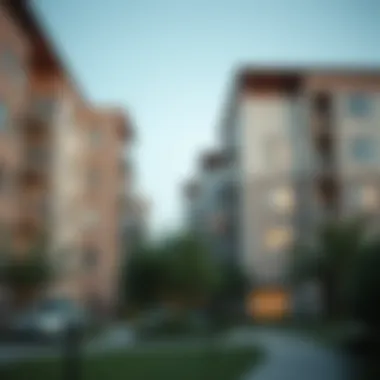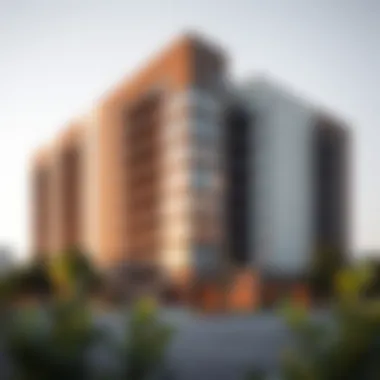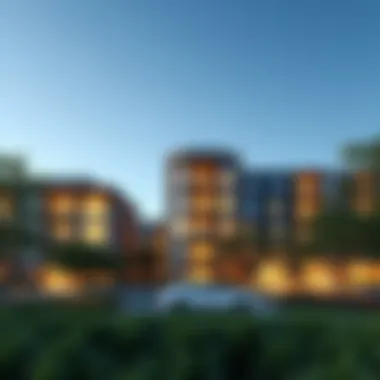Exploring the Varieties of Multifamily Housing


Intro
Multifamily housing represents a significant component of urban and suburban environments, catering to the ever-growing demand for diverse living solutions. As cities expand, the need for innovative housing developments is increasingly palpable, pushing design boundaries while addressing community needs. Multifamily properties, ranging from bustling apartment complexes to cozy duplexes, not only provide accommodation but also contribute to vibrant community dynamics.
The rapid evolution in this sector reflects broader societal changes, including shifts in demographics, lifestyle preferences, and economic factors. With young professionals and families alike seeking out flexible living arrangements, understanding the variety of multifamily housing options becomes crucial. This exploration will unpack the nuances of different styles, their architectural traits, and the value they bring to urban residents. By recognizing these multifaceted elements, real estate enthusiasts will gain insights into how multifamily housing affects community ecosystems at large.
In this article, we will uncover:
- The spectrum of multifamily housing types and their unique characteristics
- Architectural features that define these spaces
- Market trends shaping their development
- How these properties meet the needs of modern urban living
So, let’s take a closer look at the distinctive features and location highlights of multifamily housing.
Defining Multifamily Housing
Defining multifamily housing is essential for understanding the broader scope and nuances of residential living in today's world. Recognizing what constitutes multifamily housing allows enthusiasts and investors to grasp not just the physical structures but also the socioeconomic dynamics that accompany them. Multifamily housing can be seen as a key component of urban infrastructure, offering various living arrangements that cater to different demographics—families, singles, and retirees alike.
The importance of this topic lies not only in its diversity but also in its capacity to provide solutions to pressing housing challenges. As cities become more crowded, traditional single-family homes often turn into rare commodities, inflating prices and making it difficult for newcomers and lower-income individuals to find affordable living spaces. Multifamily housing steps in to bridge that gap, enabling more efficient land use and accommodating growing populations.
Exploring the myriad benefits and considerations related to multifamily housing helps contribute to a well-rounded perspective. For instance, multifamily residences can ease the burden of urban sprawl by vertically utilizing land, effectively creating compact communities where services and amenities are within arm's reach. Moreover, they present opportunities for shared facilities, which can foster a sense of community among residents.
Understanding these characteristics is vital for anyone looking to invest in or appreciate real estate in today’s ever-evolving landscape.
Understanding Multifamily Housing
To delve deeper into multifamily housing, it’s useful to understand its core concepts. Multifamily housing is typically defined as residential properties designed to accommodate multiple separate housing units under one roof or within a complex. This arrangement can take various forms, including apartments, condominiums, and townhouses, allowing for diversity in living styles.
Key features of multifamily housing include:
- Multiple Dwellings: Each unit is distinct and often includes its own kitchen and bath. Residents enjoy both independence and community.
- Shared Amenities: Multifamily complexes frequently offer shared amenities, such as laundry facilities, pools, and recreational areas, enhancing the living experience and promoting social interaction.
- Economic Considerations: These buildings can generate rental income, creating an avenue for property owners and investors to benefit financially.
Property management in multifamily housing often plays an important role, too. Ensuring the upkeep and smooth operation of shared spaces falls on management teams, while residents must navigate any associated rules and fees.
Historical Context
The evolution of multifamily housing traces back to the earliest urban settlements, evolving just like the societies in which they are situated. Initially, multifamily dwellings emerged as communal living arrangements, often from practical needs related to security, resource sharing, and economic efficiency. Historical records showcase the use of courtyard-style housing in ancient civilizations, revealing a long-standing tradition of people living in proximity.
During the industrial revolution, multifamily housing saw a significant transformation. The urban migration fueled the construction of tenements and apartment blocks to accommodate the working class. These buildings often represented both the promise of better living conditions and stark realities of overcrowding. As cities expanded, so did multifamily developments, adapting to the needs of an ever-increasing population.
In the post-World War II era, the definition of multifamily housing broadened even further, giving rise to modern apartment complexes and condominiums that emphasize not just functional living spaces but also style and amenities. The sociocultural shifts led to various types of multifamily housing being tailored to meet diverse preferences and income levels.
With the turn of the 21st century, trends in multifamily housing continue to evolve, incorporating elements like sustainability and technology to cater to modern lifestyles. Understanding the historical context of multifamily housing sheds light on its present significance and ongoing development in the urban fabric.
Types of Multifamily Housing
Understanding the multitude of options in the multifamily housing market is vital for anyone interested in real estate or urban development. It’s not simply about finding a home but exploring what each type can provide in terms of lifestyle, investment opportunities, and community dynamics. Multifamily housing is designed to accommodate the diverse needs of families, professionals, and singles, making it a flexible choice for many. Furthermore, knowing the different forms of multifamily housing can aid communities in shaping their very identity and vitality.
Apartments
Market-Rate Apartments
Market-rate apartments are quite a prominent option in the multifamily sector. Available at a price point determined by market conditions, they provide flexibility that many seek. One key characteristic of these apartments is their appeal to a broad audience, including young professionals and families. They are usually located in urban settings where commuting is less of a hassle. The unique feature here is affordability compared to luxury apartments, while still offering a range of amenities, like gyms and communal areas.
However, one must appreciate the limitations: these apartments might face rapid rent increases in sought-after areas due to demand. This situation could strain those who choose these living arrangements, posing the risk of moving away if costs become unmanageable.
Luxury Apartments
Shifting gears to luxury apartments, it’s clear they play a distinct role in the market as they cater to individuals seeking opulent living. They are characterized by high-end finishes and exclusive amenities such as rooftop terraces, concierge services, and state-of-the-art gyms. People tend to choose luxury apartments for their lifestyle enhancements, landscape views, and proximity to entertainment hubs, making them a desirable investment.
On the flip side, they come with a hefty price tag. Costs can often make these apartments inaccessible for many. Additionally, high turnover rates can disrupt community bonds and foster a transient lifestyle among residents.
Affordable Housing Options


In contrast, affordable housing options aim to alleviate the burden of housing costs for lower-income individuals and families. The core aspect is the commitment to keep rent at a manageable proportion of a resident's income. These homes can directly address the challenges many face in finding satisfactory living spaces within their budget, thereby enhancing community stability.
Unique features often include government subsidies or tax incentives for builders, making it possible to create livable units at lower prices. However, they may sometimes be constructed in less desirable locations, leading to concerns about transportation and access to services.
Condominiums
Owner-Occupied vs. Rented Condos
Condominiums represent another layer of multifamily housing, standing out because they can be owner-occupied or rented. Owner-occupied condos present a sense of ownership, which often leads to a more committed community atmosphere. These places usually flaunt communal rules, making them an excellent choice for residents looking for a stable environment.
Conversely, rented condos may attract residents who prefer flexibility over permanence. However, this might lead to a transient environment. Furthermore, owners have to navigate the complexities of homeowner associations and associated fees, which can be cumbersome.
Common Areas and Amenities
When it comes to common areas and amenities in condominiums, they are essential selling points. These features often foster community interaction and provide additional attractions like swimming pools, fitness centers, and gardens. This communal setup can enhance the living experience significantly. However, there's a catch. Higher maintenance fees can put a strain on residents with limited budgets, potentially leading to dissatisfaction and conflict among owners.
Townhouses
Design Features
Townhouses boast unique architectural designs that set them apart from traditional apartments or condos. They allow for an individual feel while still being part of a community. One characteristic worth noting is their vertical structure, often with multiple levels, giving families a spacious feel. This design can also prove beneficial for outdoor lovers. Townhouses typically offer small private yards or gardens, adding that touch of personal outdoor space. However, limited lot size might constrain true gardening efforts for those hoping for a lush landscape.
Benefits of Living in a Townhouse
Living in a townhouse often comes with a blend of benefits that appeal to families and young professionals alike. Many still cherish the house feel with distinctive entrances and the absence of shared walls. Homeowners can enjoy the balance between privacy and community. However, potential downsides include homeowners association fees, which can weigh heavily on finances.
Duplexes and Triplexes
Variations and Layouts
Duplexes and triplexes are versatile designs that provide multifamily living while giving each unit a semblance of independence. They usually feature side-by-side or stacked layouts, making them enjoyable choices for multigenerational families or those wanting to rent out a portion of their property. Their varied configurations can often serve various living arrangements or rental strategies.
Though, the noise levels in these living arrangements can present issues. Residents must be considerate of their neighbors, which may not suit everyone’s preference.
Investment Potential
The investment potential for duplexes and triplexes is noteworthy. They offer the opportunity for a steady cash flow by renting out additional units. This can lower living expenses for owners significantly. However, they come with responsibilities, such as maintenance and tenant management, which might not appeal to every investor.
Cooperative Housing
Structure and Governance
Cooperative housing presents a unique structure where residents own shares in the corporation that manages the building. This arrangement fosters a collective decision-making process regarding living conditions and community rules. The emphasized communal living can strengthen neighborhood ties. However, the lengthy approval processes and share transfer restrictions might make it less appealing compare to other options.
Advantages and Disadvantages
On the advantages side, cooperative living tends to have lower costs due to shared expenses and promotes a sense of belonging. However, on the downside, rules can be quite stringent, limiting personal freedom in modifications or usage of space.
Mixed-Use Developments
Integration of Residential and Commercial Spaces
Mixed-use developments combine residential and commercial spaces, creating a lively ambiance. This integration allows convenience at the doorstep. The character of these developments brings together shops, eateries, and living areas within a single locale. Oftentimes, residents find they can walk to their daily needs without the need for a car, enhancing sustainability.
That said, some risk over-commercialization and resulting noise can disrupt the residential component. Plus, property values can fluctuate based on commercial success.
Impact on Urban Planning
Finally, mixed-use developments have significant ramifications for urban planning. They embody the aim of creating vibrant, accessible communities that cater to diverse lifestyles. Well-planned mixed-use areas can revitalize tired neighborhoods and lead to enhanced public amenities. The balancing act comes down to ensuring that such developments offer genuine benefits to residents and do not simply cater to commercial interests at their expense.
Market Dynamics


Understanding the market dynamics surrounding multifamily housing is critical for comprehending how it accommodates diverse living needs. These dynamics shape everything from pricing to design trends, and they inform decision-makers, whether residents, investors, or urban planners. It’s crucial to analyze demand trends and investment opportunities, both of which influence how multifamily properties evolve in urban landscapes.
Demand Trends
Urban Migration Patterns
Urban migration patterns serve as a barometer for multifamily housing demand. Individuals and families flock to cities, attracted by job opportunities and amenities. This trend is particularly prominent among young professionals seeking vibrant lifestyles. The shifting demographic landscape introduces a notable characteristic: urban areas are becoming melting pots of culture and creativity. It also influences the architectural styles of multifamily dwellings, which tend to lean towards modern aesthetics that appeal to younger generations.
The benefits of urban migration foster a sense of community; it’s almost like a potluck dinner where everyone brings a unique dish to the table. People from different backgrounds share their experiences and ideas. However, there might be downsides, including increased rents and potential overcrowding, threatening to dilute the very charm that makes urban living appealing.
"Urban migration is not just about where people live, but how they connect."
Influences of Remote Work
The rise of remote work has made waves in multifamily housing market dynamics. As companies embrace flexible work options, more people are seeking dwellings that cater to their new lifestyle. This shift means that individuals no longer have to live near their workplace, leading to migration to quieter suburbs or even rural areas.
A key aspect of this trend is the emergence of properties designed with home offices in mind. The multifamily spaces that offer work-friendly amenities are gaining traction. Homeowners who invest in properties with such features are often reaping the benefits of rental income, as they cater to tenants who prioritize ease of work-life balance. However, the challenge lies in adapting existing units to meet these new needs without incurring prohibitive costs.
Investment Opportunities
Pros and Cons of Multifamily Investments
Exploring multifamily investments opens up a realm of possibilities, but it’s vital to weigh the pros and cons. On one hand, investing in multifamily properties can lead to steady cash flow and potential appreciation in value. It’s like having a money tree that grows on its own — manage it well, and it keeps providing. The key characteristic of multifamily investments lies in their ability to generate income from multiple units, reducing risk compared to single-family investments.
On the downside, many investors find themselves knee-deep in paperwork, managing tenants, and dealing with maintenance issues. Additionally, fluctuating market conditions can impact occupancy rates, presenting potential pitfalls. Learning the ropes is crucial for any investor keen on this path.
Financing Options for Investors
Financing options for multifamily investments come in various forms, making it accessible for those ready to take the plunge. Common methods include traditional bank loans, government-backed loans, and even private investors or syndications. Each option plays a vital role in shaping how one approaches multifamily housing ventures.
The beauty of this versatility is that it allows for strategic entry points based on individual financial capabilities and investment goals. However, one must be careful; not all financing options are created equal. Some may come with onerous terms and conditions, which could sour the potential profits. Investors would be wise to conduct thorough research before committing.
Design Considerations
Design considerations are paramount when it comes to multifamily housing, influencing not only the aesthetic appeal but also the functionality and sustainability of these living spaces. As cities evolve and populations grow, it’s essential that multifamily units cater to the diverse needs of residents while fostering a sense of community. Investing time in design allows developers to create environments that not only look appealing but also serve their intended purpose effectively.
Sustainability in Multifamily Housing
Energy Efficiency Standards
Energy efficiency standards represent a foundational element of sustainable design in multifamily housing. These standards focus on minimizing energy usage, reducing bills, and, importantly, lowering the ecological footprint of buildings. One key characteristic of these standards is their requirement for high-performance insulation and energy-efficient systems like HVAC, lighting, and water heating.
Utilizing these standards not only appeals to the environmentally conscious tenant but often offers financial savings long term for both developers and residents. A unique feature of energy efficiency measures is the potential for rebates or incentives provided by government programs, making them an attractive choice for new developments. However, some challenges exist, such as the initial costs of implementation and the need for continuous updates to meet evolving regulations or technology advancements.
Use of Sustainable Materials
Choosing sustainable materials is another vital aspect of modern multifamily housing. This approach emphasizes the use of naturally sourced, renewable, and recycled materials which aid in reducing waste and improve indoor air quality. The key characteristic of using sustainable materials is their lower impact on the environment; they contribute to a healthier living space and ecosystem.
Materials like bamboo, reclaimed wood, or recycled metal not only uphold eco-friendly practices but can also add distinct character to the design of the structure. An interesting feature here is that sustainable materials often enhance the marketability of a property, attracting residents who prioritize eco-conscious living. Nevertheless, this option can sometimes result in higher upfront costs and may require careful sourcing to ensure quality.
Aesthetic Appeal
Architectural Styles
Architectural styles are a vital component in the discussion of multifamily housing design. They not only create visual interest but also reflect the cultural and historical context of the community. Popular styles - be it modernist, gothic, or ever so trendy mid-century modern - can influence a neighborhood's identity. A significant aspect is that a well-chosen architectural style can improve property value and marketability.
Unique features of these styles might include innovative use of space and creative layouts. Each style carries potential advantages; for example, certain modern designs may favor extensive natural light and open floor plans, while traditional styles may create a more inviting, homey feel. However, it's essential to balance personal taste and community standards, as some residents might prefer one style over another or worry about the diversity and integration of their living environment.
Interior Design Trends
Interior design trends are equally crucial, as they shape how residents feel within their living spaces. Trends can range from minimalist aesthetics to vibrant urban décor that reflects the lifestyle of inhabitants. In this modern age, open concept designs and multifunctional furniture are particularly popular, accommodating the needs of smaller spaces while maximizing usability.


A key characteristic here lies in the focus on comfort and community spaces. Many newer developments now incorporate shared amenities such as rooftop gardens, lounges, and workspaces, encouraging resident interaction and community building. An interesting feature to note is the integration of personal style with functional design; this can enhance the overall living experience. However, staying ahead of trends requires regular adaptation and careful budgeting, something that both developers and residents must navigate.
By recognizing the importance of design considerations, industry professionals can create multifamily housing that meets the ever-evolving needs of contemporary society.
In summary, the design considerations for multifamily housing are varied and multifaceted. By prioritizing sustainability, aesthetics, and functional requirements, stakeholders can ensure that these residences not only meet immediate needs but also foster lasting communities.
Regulatory Framework
In the world of multifamily housing, understanding the regulatory framework is crucial. These rules and guidelines help shape the development, construction, and management of properties that house multiple families. With demand soaring for diverse living arrangements, an intricate set of regulations governs everything from zoning laws to building codes. Familiarity with these regulations benefits not only developers and investors but also residents seeking a harmonious environment.
Zoning Laws
Zoning laws dictate how land can be used and what types of buildings can be constructed in specific areas. These laws are essential to maintaining order in communities and ensuring that the land is utilized effectively. For instance, a neighborhood designated for residential use will have restrictions preventing commercial developments from popping up haphazardly, which could disrupt local ecosystems, traffic patterns, and improved livability.
Key points to consider regarding zoning laws include:
- Use Classes: Different areas are categorized for specific purposes such as residential, commercial, and industrial. This helps keep communities well-organized and livable.
- Development Restrictions: Zoning can control the density of multifamily housing, regulating how many units can be built within certain plots. This affects local infrastructure and resources such as schools, roads, and public transport.
- Variances and Exceptions: Sometimes developers request changes to zoning designations. This can lead to case-specific adjustments that might support unique community needs but could also generate controversy among long-term residents.
Understanding zoning laws can empower real estate professionals and investors to make informed decisions. More importantly, it can enhance community engagement by ensuring that developments meet the needs of the local populace.
Building Codes
Building codes serve as the safety net for construction. They are a collection of regulations governing the design, construction, and alteration of buildings. This ensures that structures not only meet aesthetic standards but are also safe, efficient, and durable. For multifamily housing, these codes can be particularly complex due to the various occupants each building must accommodate.
Important components of building codes include:
- Safety Standards: These include regulations pertaining to fire safety, structural integrity, and accessibility. Each element is essential for preventing hazards and ensuring the welfare of all residents.
- Energy Efficiency: Many building codes have evolved to include sustainable practices and energy-efficient designs, emphasizing the need for eco-friendly structures that reduce carbon footprints.
- Maintenance Requirements: Ongoing assessments and repairs are outlined in building codes to ensure that multifamily buildings remain safe and livable over time.
As populations grow and the demand for multifamily housing rises, adhering to building codes becomes increasingly vital. Complying with these codes can help reduce liability issues and foster community trust.
"Regulatory frameworks are not just red tape; they create the foundation of the living environment, ensuring safety and sustainability for everyone involved."
In summary, the regulatory framework surrounding multifamily housing plays a pivotal role in modern development. From zoning laws that guide the type and density of buildings to building codes that ensure safety and durability, navigating these regulations is essential for anyone involved in the multifamily housing sector. Understanding this landscape can lead to better investment strategies, more thoughtful community designs, and ultimately, enhanced living conditions for residents.
Future of Multifamily Housing
As the dynamics within urban environments continue to shift, understanding the trajectory of multifamily housing has never been more pertinent. This section addresses emerging innovations and community-focused strategies shaping the future landscape. Both developers and policy-makers are tasked with the challenge of creating versatile spaces that not only cater to diverse populations but also enhance quality of life. This endeavor includes integrating technology, enhancing community engagement, and promoting sustainability—a trifecta of elements that ensure multifamily housing remains a viable and attractive option for future living.
Emerging Trends
Smart Home Technologies
Smart home technologies have rapidly gained momentum, infusing a new layer of convenience and efficiency into multifamily housing. These technologies encompass systems like smart thermostats, automated lighting, and security features all designed to enhance the living experience. A key characteristic here is the connectivity offered by these devices, simplifying daily routines and reducing energy consumption. This integration contributes to a modern lifestyle where comfort meets sustainability, making it a favored choice among prospective tenants.
However, the installation of smart home systems can carry initial costs that might deter some developers. The perception of added value, however, often outweighs these concerns, as many residents appreciate the potential for long-term savings on utilities and enhanced living conditions.
Adaptations Post-Pandemic
The pandemic has forced a reevaluation of how spaces are designed and utilized. Adaptations post-pandemic focus on creating flexible layouts that can accommodate changing needs. One salient feature of this trend is the integration of shared spaces that promote social distancing while fostering community interaction. Areas designed for remote work, outdoor gatherings, and communal activities have become staples in new multifamily developments.
This shift is increasingly popular because it acknowledges the evolving nature of work and social engagement. However, achieving the right balance between private and communal spaces is a delicate task—too much of either can lead to dissatisfaction amongst residents.
Community Building Initiatives
Enhancing Neighborhood Engagement
Enhancing neighborhood engagement is pivotal in the future of multifamily housing. Community initiatives, such as organized events or shared communal gardens, nurture connections between residents. This approach is beneficial because it fosters a sense of belonging, transforming mere housing into a supportive community.
Such initiatives can also be cost-effective ways of improving tenant satisfaction, although they require consistent effort from management and residents alike to maintain momentum. The unique feature of resident-driven activities promotes inclusivity and shared ownership, making neighborhoods more vibrant and cohesive.
Sustainable Community Practices
Sustainable community practices are gaining traction as multifamily housing evolves. These practices include green building methods, localized food sourcing, and recycling programs to reduce environmental footprints. A significant characteristic that sets these practices apart is the focus on collective responsibility—residents are encouraged to participate actively in sustainability efforts, which can enhance their sense of community.
While there are evident advantages, such as aligning with global sustainability goals, challenges arise in ensuring broad participation. Not all residents may be equally committed to these initiatives, making it vital for developers to instill a pervasive culture of sustainability from the outset.
"The future of multifamily housing lies in its capacity to adapt, incorporating innovations that prioritize not just living space, but a cohesive, engaged community."
As multifamily housing continues to evolve, it is clear that a blend of technology, adaptive strategies, and community engagement will play critical roles in supporting the housing needs of diverse populations.







